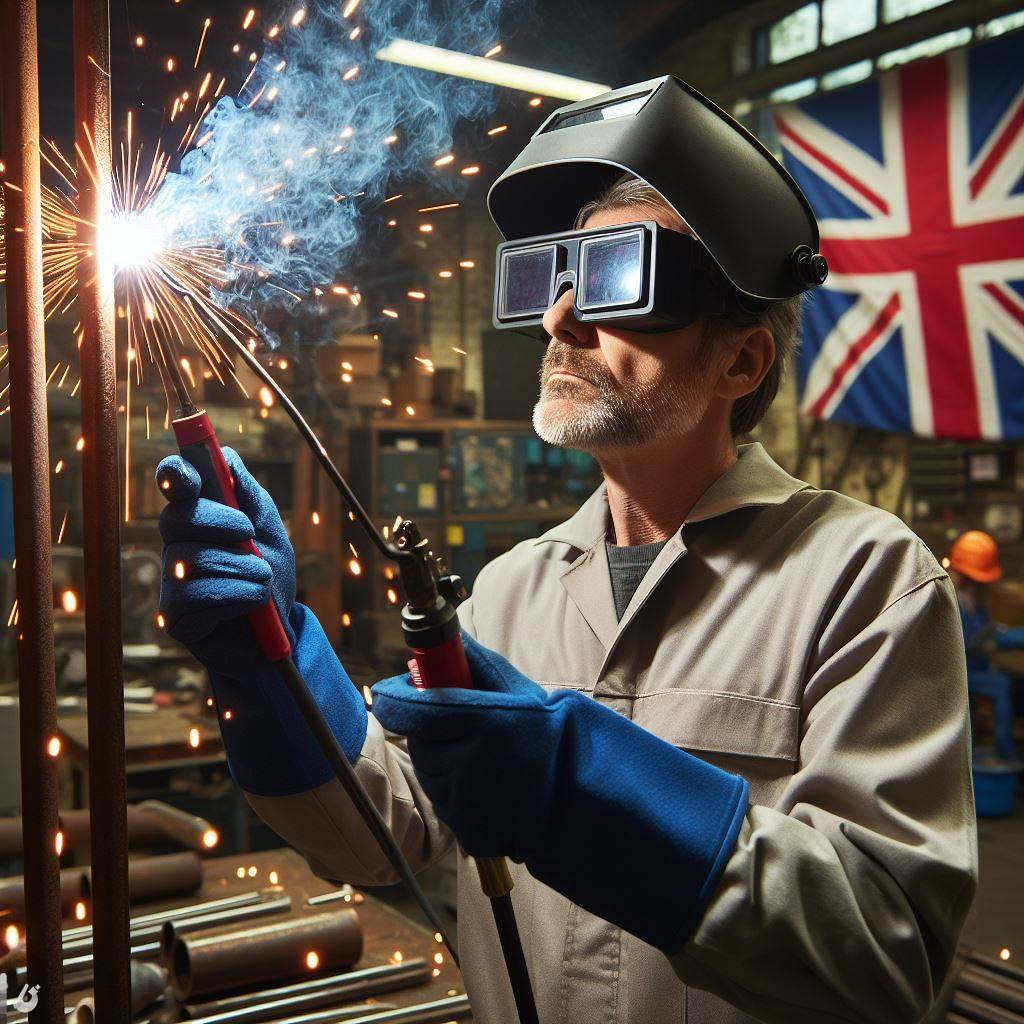Introduction
A. Welding as a Profession in the UK
Welding is a dynamic profession vital to UK industries, from construction to manufacturing.
Skilled welders contribute significantly to the country’s infrastructure and development.
B. Importance of Using the Best Welding Techniques
In the welding realm, technique is paramount.
The right approach ensures structural integrity, safety, and the longevity of welded components.
Employing the best techniques is non-negotiable for quality work.
C. Overview of the Blog Post
- Optimal Techniques for Seamless Welds: Discover the techniques that lead to strong, flawless welds, addressing both aesthetic and structural considerations.
- Safety Protocols: A Welder’s Best Ally: Explore essential safety measures that should be ingrained in every welder’s routine, fostering a secure working environment.
- Materials Matter: Matching Techniques to Metal: Understand the significance of material compatibility and how different welding techniques suit specific metals, optimizing results.
This blog post serves as a comprehensive guide for UK welders, offering insights into refining skills, ensuring safety, and achieving excellence in the craft.
Common Welding Techniques in the UK
A. The most commonly used welding techniques in the UK
- Stick Welding: Also known as Shielded Metal Arc Welding (SMAW), it uses an electrode coated in flux to create the weld.
- MIG Welding: Metal Inert Gas (MIG) welding uses a consumable wire electrode and shielding gas for a faster and efficient process.
- TIG Welding: Tungsten Inert Gas (TIG) welding produces high-quality welds using a non-consumable tungsten electrode and inert gas.
- Flux-Cored Arc Welding (FCAW): Similar to MIG welding, but with a tubular wire filled with flux, providing better protection.
- Submerged Arc Welding (SAW): An automatic welding technique that uses a continuously fed electrode and a layer of flux.
B. Advantages and disadvantages of each technique
1. Stick Welding
- Advantages: Suitable for outdoor and windy conditions, cost-effective, versatile, and easy to learn.
- Disadvantages: Slow process, produces more spatter, requires good hand-eye coordination and post-weld cleaning.
2. MIG Welding
- Advantages: Fast and efficient, suitable for thin materials, high deposition rates, minimal cleaning required.
- Disadvantages: Less suitable for outdoor use, requires a constant power supply, produces more heat and sparks.
3. TIG Welding
- Advantages: Produces high-quality welds, precise control, suitable for various materials, no spatter or flux required.
- Disadvantages: Slower process, requires more skill and experience, limited to smaller thicknesses.
4. Flux-Cored Arc Welding
- Advantages: High welding speeds, deeper penetration, suitable for thick materials, less affected by wind or drafts.
- Disadvantages: Produces more smoke and fumes, requires good ventilation, slower travel speed compared to MIG welding.
5. Submerged Arc Welding
- Advantages: High deposition rates, deep penetration, suitable for thick materials, less operator skill required.
- Disadvantages: Limited to flat or horizontal positions, specialized equipment and setup, slower than other techniques.
C. Importance of selecting the right techniques based on the project requirements
Choosing the appropriate welding technique is crucial to ensure the success of a project.
Factors to consider include:
- Material type and thickness: Different techniques work best with specific materials and thicknesses.
- Weld quality requirements: Some techniques produce higher-quality welds, suitable for critical applications.
- Time and efficiency: Faster techniques may be necessary for high-volume production or time-sensitive projects.
- Environmental considerations: Outdoor projects may require techniques less affected by wind or require better ventilation.
- Operator skill level: Certain techniques demand more training and experience to achieve desired results.
By carefully evaluating the project requirements and understanding the advantages and disadvantages of each welding technique, UK welders can make informed decisions, leading to successful and cost-effective outcomes.
Read: Historical Evolution of Plumbing in UK
Tips for Choosing the Best Welding Technique
When it comes to welding, choosing the right technique is crucial to ensure the best results.
Factors such as the materials being welded, project requirements, as well as time and budget constraints should all be taken into consideration.
In this section, we will explore tips for selecting the best welding technique.
A. Understanding the materials being welded
1. Different techniques suitable for different materials
Not all welding techniques are suitable for every material.
It is important to consider the properties of the materials involved, such as their thickness, composition, and heat sensitivity.
Personalized UK Career Consulting
Receive tailored career guidance designed just for you. Get actionable steps and expert support to boost your career in 1-3 days. Take control of your career now.
Get StartedFor example, gas metal arc welding (GMAW) is commonly used for steel, while tungsten inert gas (TIG) welding is preferred for aluminum.
2. Factors to consider when selecting techniques based on material properties
When choosing a welding technique, factors like the material’s mechanical properties, tensile strength, corrosion resistance, and thermal conductivity should be taken into account.
Different techniques may have varying effects on these properties, so it is important to choose a method that will not compromise the integrity of the materials.
B. Assessing the project requirements
1. Identifying the desired strength and durability
Before selecting a welding technique, it is essential to determine the required strength and durability of the weld.
This will help in deciding whether a particular technique, such as shielded metal arc welding (SMAW) or flux-cored arc welding (FCAW), can fulfill the desired project specifications.
2. Determining the aesthetic appearance required
For projects where the appearance of the weld is important, factors like the smoothness, cleanliness, and overall aesthetics should be considered.
Certain techniques, such as gas tungsten arc welding (GTAW), are known for producing cleaner and more aesthetically pleasing welds, making them suitable for applications where appearance is crucial, such as architectural projects.
C. Evaluating time and budget constraints
1. Considering the cost-effectiveness of each technique
Welding techniques vary in terms of their cost-effectiveness.
Factors such as equipment costs, consumables, and labor should all be taken into account.
Techniques like laser beam welding (LBW) may offer higher precision and speed but can be costly, while techniques like shielded metal arc welding (SMAW) are generally more affordable but may take longer to complete a project.
2. Assessing the time required for each technique
Time constraints are also crucial when selecting a welding technique.
Some techniques, such as resistance spot welding (RSW), offer rapid welding times, making them suitable for high-production situations.
However, other techniques like gas tungsten arc welding (GTAW) may require more time due to the need for careful preparation and slower cooling times.
In essence, selecting the best welding technique requires a thorough understanding of the materials being welded, careful assessment of the project requirements, and evaluation of time and budget constraints.
Your Dream Job Starts with a Perfect CV
Get a tailored CV and cover letter that captures your unique strengths and stands out in your industry. Let us help you make an unforgettable first impression.
Get StartedBy considering these factors, UK welders can ensure that they choose the most suitable technique for each project, ultimately achieving high-quality welds.
Read: Major Plumbing Issues in UK Homes

Best Welding Techniques in Specific Scenarios
When it comes to welding, different materials require specific techniques to ensure quality and durability.
In this section, we will explore the best welding techniques for specific scenarios such as structural steel, aluminum, and stainless steel.
A. Welding techniques for structural steel
Structural steel is commonly used in construction due to its high strength and durability.
To achieve strong and reliable welds when working with structural steel, the following techniques are recommended:
- Butt joint: This technique is commonly used for joining structural steel members by aligning the edges and welding along the seam to create a strong bond.
- Fillet weld: When joining structural steel components at right angles, a fillet weld is often used to create a triangular-shaped weld along the joint to distribute the stress evenly.
To achieve strong and durable welds in structural steel, it is essential to follow these tips:
- Cleanliness: Ensure that the welding area is free from dirt, rust, or any contaminants that may weaken the weld.
- Preheat: Preheating the steel before welding can reduce the risk of cracking and improve the weld’s overall quality.
B. Welding techniques for aluminum
Aluminum possesses unique properties that require specific welding techniques to ensure a strong and reliable weld.
The following techniques are suitable for welding aluminum:
- Tungsten Inert Gas (TIG) welding: TIG welding is commonly used for aluminum due to its ability to produce clean and precise welds.
- MIG welding: MIG welding is also suitable for welding aluminum, especially for thicker materials, as it provides higher deposition rates.
When working with aluminum, it is important to take the following precautions:
- Use proper filler material: Select a filler material that matches the composition of the aluminum to ensure compatibility and prevent weak welds.
- Control heat input: Aluminum has a high thermal conductivity, making it prone to distortion. Controlling the heat input during welding can help prevent distortion and maintain structural integrity.
C. Welding techniques for stainless steel
Stainless steel is known for its excellent corrosion resistance and strength, making it a popular choice in various industries.
To achieve strong and corrosion-resistant stainless steel welds, the following techniques are recommended:
- Gas Tungsten Arc Welding (GTAW) or TIG welding: TIG welding is commonly used for stainless steel due to its ability to provide precise control over the weld and produce high-quality results.
- Ferritic stainless steel welding: When welding ferritic stainless steel, using a low heat input and controlling the interpass temperature can help prevent distortion and brittleness in the weld.
By following these recommended welding techniques, welders can achieve superior weld quality and ensure the longevity and integrity of the welded structures.
Read: Safety Practices for Carpenters in the UK
Optimize Your LinkedIn for Success
Boost your LinkedIn profile with a professional bio, keyword-rich headline, and strategic recommendations that attract recruiters. Stand out from the crowd and get noticed.
Optimize NowSafety Considerations and Precautions
A. Importance of safety measures in welding
- Safety should be a top priority for welders as it is a high-risk occupation.
- Welding activities involve potential hazards such as electric shock, fire, explosions, and toxic fumes.
- By implementing safety measures, welders can protect themselves and their colleagues from accidents and injuries.
- Employers have a legal responsibility to provide a safe working environment for welders, including proper safety training.
B. Personal protective equipment (PPE) required for different welding techniques
- Welders must wear appropriate PPE to safeguard against hazards in their specific welding environment.
- For all welding techniques, essential PPE includes welding helmets, protective eyewear, and flame-resistant clothing.
- Welders should also wear gloves, preferably made of leather or other heat-resistant materials, to protect their hands.
- Respiratory protection is crucial when dealing with fumes and gases, so welders should wear respirators or masks.
- PPE requirements may vary for different welding techniques such as MIG, TIG, stick welding, or plasma cutting.
- It is essential to consult safety guidelines and regulations for each welding technique to determine the necessary PPE.
C. Precautions to prevent accidents and injuries during welding
- Before starting any welding job, thorough risk assessments should be conducted to identify potential hazards.
- Adequate ventilation is necessary to control fumes, gases, and airborne particles in the welding area.
- Fire safety is crucial, and flammable materials must be kept away or adequately protected during welding operations.
- Proper grounding of equipment and workpieces helps prevent electric shocks and other electrical accidents.
- Welders should ensure proper training and certification, as lack of expertise can lead to accidents.
- Regular equipment inspection and maintenance are essential to prevent malfunctions and avoid accidents.
- Welders should be aware of emergency procedures and have access to firefighting equipment and first-aid kits.
- Communication is vital during welding activities, and clear signals and warnings should be established among team members.
- Welders should practice good housekeeping, keeping the work area clean and organized to minimize tripping hazards.
- Overexposure to ultraviolet (UV) radiation can cause eye damage, so welders should take breaks and use protective filters.
In review, safety is of utmost importance in the welding profession.
By implementing proper safety measures, wearing appropriate PPE, and following precautions, welders can minimize the risks of accidents and injuries.
It is essential for both employers and welders to prioritize safety to create a secure working environment.
Regular training and adherence to established safety guidelines are crucial to ensure the well-being of welders and their colleagues.
Read: Commercial vs. Residential Plumbing in UK
Conclusion
A. Recap of the main points discussed in the blog post
Throughout this blog post, we have explored various welding techniques and tips that are essential for UK welders.
We started by discussing the importance of selecting the best welding techniques for specific projects.
B. Importance of choosing the best welding techniques for UK welders
Selecting the appropriate welding technique plays a crucial role in ensuring the success of welding projects.
By understanding the different techniques available and their specific applications, UK welders can achieve better results and enhance their overall productivity.
C. Encouragement to apply the tips and techniques shared for successful welding projects
We strongly encourage UK welders to apply the strategies and techniques shared in this blog post to improve their welding skills.
By implementing these tips, welders can enhance their craftsmanship, produce stronger welds, and reduce the likelihood of errors or defects in their work.
In the end, mastering the best welding techniques is essential for UK welders looking to excel in their craft.
By carefully choosing the appropriate technique for each project and consistently applying the tips and techniques discussed, welders can achieve great results and establish themselves as skilled professionals in the industry.
Keep practicing and always strive to improve your skills for successful welding endeavors.
[E-Book for Sale]
500 Cutting-Edge Tech Startup Ideas for 2024 & 2025: Innovate, Create, Dominate
$19.99 • 500 Tech Startup Ideas • 62 pages
You will get inspired with 500 innovative tech startup ideas for 2024 and 2025, complete with concise descriptions to help you kickstart your entrepreneurial journey in AI, Blockchain, IoT, Fintech, and AR/VR.




